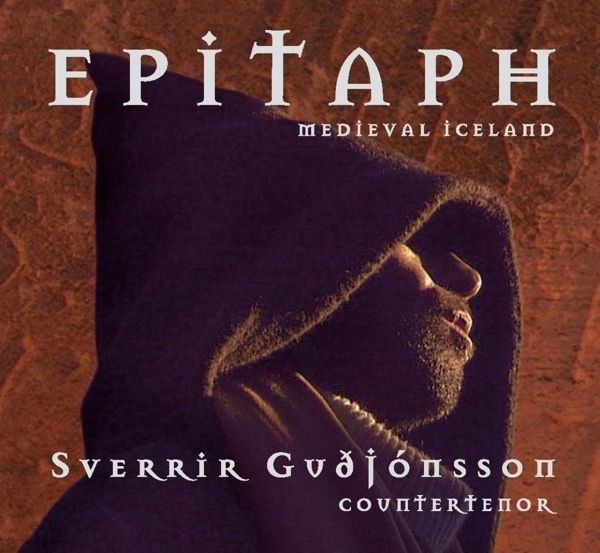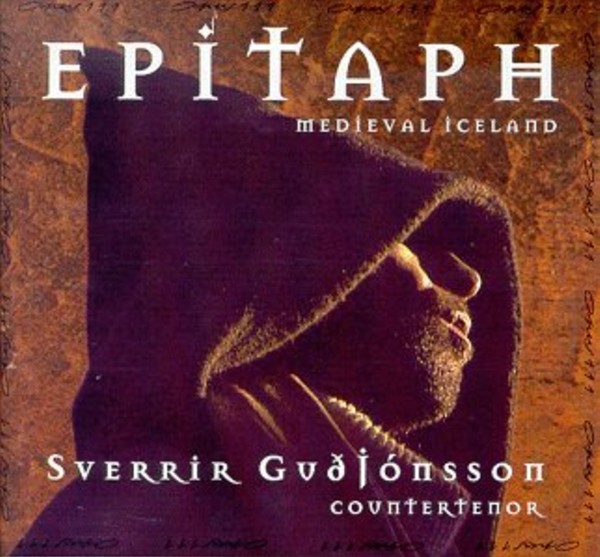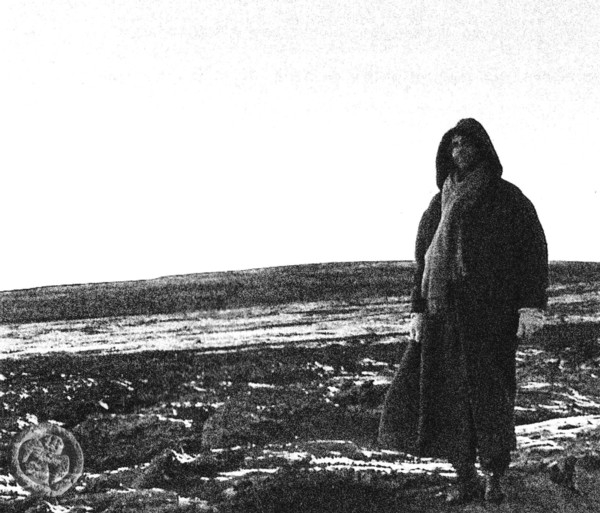
medieval.org
Opus 111 OPS 30-253
(Smekkleysa, 2011)
recorded in Skálholt Church, Iceland, 1998

medieval.org
Opus 111 OPS 30-253
(Smekkleysa, 2011)
recorded in Skálholt Church, Iceland, 1998
"These are traditional Icelandic songs
and as said by the interpret:
"Epitaph" has been given space and
time to develop. It is a lifelong project which has grown and matured
with age. The heritage of Iceland is preserved within these songs,
which have been passed on from generation to generation, through the
centuries.
The counter-tenor voice is exceptionaly pure." — medieval.org
I. Prologue
SÓLARUPPRÁSS
Sunrise
1. Lilja God of all people [3:26]
II
ÁRSTÍDIR Seasons
2. Austankaldinn á oss blés The cold wind blew
around us [1:34]
3. Sumarið Þegar setur blítt Summer - Joy
and sorrow [1:38]
4. Skipafregn The long Spring [1:02]
5. Sumri hallar Summer is passing [1:33]
6. Goða veislu gjöra skal Now is the time for
feasting [1:45]
III
ÁST Love
7. Blástjarnan Þótt skarti skær The
shining blue star [1:01]
8. Stóðum tvö í túni Together
we stood in the field [1:26]
9. Eitt sinn fór ég yfir Rín Once I
crossed the river Rhine [3:03]
10. Stúlkurnar ganga sunnan með sjá The
maidens are walking south by the sea [0:49]
IV
TRÚ Faith
11. Miskunnarbæn Kyrie [1:18]
12. Tunga mín vertu treg ei á My tongue, be
not reluctant [1:49]
13. Vera mátt góður You may be good [0:48]
14. Lánið drottins lítum mæta Praise
the Lord [1:31]
15. Einsetumaður einu sinni The hermit [2:26]
16. Guðs lamb Agnus Dei [1:10]
V
NÁTTÚRA Nature
17. Veröld fláa Wicked world [1:05]
18. Bar svo til í byggðum It happened in the
hamlet [1:57]
19. Ókindarkvæði The troll song [1:41]
20. Óll náttúran enn fer að deyja Once
again nature is dying [0:48]
21. Kvölda tekur An evening prayer [2:21]
VI
ÁRDAGAR Dawn
of man
22. A solis ortus cardine [1:41]
23. þat mælti mín móðir Thus
spoke my mother [0:37]
24. Sonarharmur The son's lament [2:11]
25. Svi vítt um heim sem sólin fer The journeys of
the sun [0:47]
VII
GRAFSKRIFT Epitaph
26. Ísland Iceland [1:30]
27. Móðir mín í kví, kví Ghost
song [2:42]
28. Krummi The raven [0:41]
29. Grafskrift Epitaph [2:14]
VIII. Epilogue
SÓLARLAG
Sunset
30. Lilja God of all people [3:53]
Sverrir Guðjónsson, counter-tenor: all singing;
original idea; arrangements for songs #1, 4, 12, 13, 3
Sigurður Halldórsson: additional voice in songs #4,
11, 14,16, 22, 23, 25
Eggert Pálsson, percussion
Ólöf Sesselja Ókarsdóttir, viola da gamba
Camilla Söderberg, recorder
Snorri Örn Snorrason, lute; arrangements for songs #2, 3,
6, 8, 15, 18-19, 21, 24, 26-29

opus 111
GRAFSKRIFT
GRAFSKRIFT hefur átt sér langan aðdraganda. Má
segja að hér sé um lífsverkefni að
ræða sem hefur vaxið, þróast og
skírst með „aldrinum". þjóðararfur
Íslendinga fellst meðal annars i þessum
söngperlum, sem varðveist hafa mann fram af manni, i gegnum
aldirnar.
Mig langaði að nálgast íslensku
þjóðlögin út frá öðru
sjónarhorni en hingað til hefur heyrst.
Hafði ég miðaldir og endurreisnar tímann í
huga, og þann hljóðfærakost sem þá
var við lýði í Evrópu, þannig að
tærleiki tónlistarinnar nyti sin sem best.
Smám saman tók verkið á sig þá
mynd sem hér ber fyrir eyru. Kaflarnir átta
(Prologue-Árstíðir-Ást-Trú-
Náttúra-Árdagar-Epitaph-Epilogue) tengjast
órjúfanlegum böndum, frá
sólarupprás til sólarlags, og mynda einhvers konar
líflínu þjóðar. Náttúran
syngur með, eins og hún hefur alltaf gert.
Öllum þeim sem vitandi eða óaðvitandi hafa
lagt hönd á plóginn, vil ég þakka af
heilum hug. Ævistarf Séra Bjarna Þorsteinssonar
„Íslensk þjóðlög» sem
prentuð voru á árunum 1906-1909, hefur reynst
mér nokkurs konar „Biblía„ og leiðandi
ljós í þessari leit.
Einnig minnist ég heillar þá Engel Lund eða
„Göggu" eins og hún var oftast kölluð,
heimssöngvara og brautryðjanda í flutningi
íslenskra þjóðlaga: „það
er um ad gera að hinkra við og hlusta, margraula lagið og
melta vísurnar, vera auðsveipur
ogþolinmóður. Pegar persóna söngvarans
víkur úr vegi kemur ef til vili í ljós,
hvernig lagið vill láta syngja sig." Gagga
lést sumarið 1996 hér í Reykjavik, 96
ára að aldri. Blessuð sé minning hennar.
Skálholtskirkja með sinn mjúkla og fagra
hljómburð varð fyrir valinu sem upptökustaður.
Staðarfólki þakka ég frábærar
móttökur og leyfi til að hljóðrita
þennan sameiginlega þjóðararf á
þessum sögufræga stað, undir verndarvæng
eldfjallsins Heklu, sem brá sér í
sumarkjólinn um vornæturstund.
Suma þessara söngva drakk
ég til min meó móðurmjólkinni.
Aðra laerði ég síðar á
lífsleiðinni.
Enn aðra varð að grafa upp úr fortíðinni.
Sverrir Guðjónsson

EPITAPH
EPITAPH has been given space and time to develop. It is a lifelong
project which has grown and matured with age. The heritage of Iceland
is preserved within these songs, which have been passed on from
generation to generation, through the centuries.
I wanted to approach these traditional Icelandic songs from a fresh
angle, to conjure up the ancient atmosphere of the Middle Ages, and a
sense of our roots which direct us into the future.
Gradually Epitaph took the dramatic form which can be heard on
this recording. The eight chapters (Prologue - Seasons - Love - Faith -
Nature - Dawn of man - Epitaph - Epilogue) are closely connected from
sunrise to sunset and reflect the lifespan of a nation. Our nature
chants along as it has always done.
I would like to thank all of those who helped along the way. Reverend
Bjarni Þorsteinsson's Traditional Icelandic Songs,
printed between 1906-1909, became a Bible to me and proved to be a
great source of inspiration. I would also like to mention the good
advice I received from Engel Lund, an international singer and pioneer
in the field of traditional Icelandic music: 'It is important to
stop and contemplate, hum the melodies over and over again, digest the
poems, and last but not least, to be humble and patient. When the
persona of the singer steps aside, the tune may reveal how it will sing
itself' Engel Lund died here in Reykjavik, at the age of 96, in
the summer of 1996.
We will always cherish her memory.
I am very grateful to have had the opportunity to record in the church
of the See of Skalholt. The beautiful and clear acoustics of this
historical church, built under the watchful eye of the volcano Hekla,
contributed so much to the atmosphere of this recording.
Epitaph brings a dramatic approach to the traditional music of
Medieval Iceland. The combination of the voice and early instruments
create the atmosphere for the haunting purity of the music and take the
listener on a journey through eight chapters from sunrise to sunset.
Some of these songs I heard in my mother's
womb
Some I learnt later in life
Some I had to dig up from the past
Sverrir Guðjónsson
Translation: Sverrir Guðjónsson/Brian FitzGibbon
I. PROLOGUE. SÓLARRUPPRÁSS
/ Sunrise
Lilja / God of all
people
An ancient and unusual melody. The lyrics are taken from a famous
Icelandic poem written by a monk in the 14th century in praise of the
Virgin Mary. The first of the hundred verses praises God Almighty who
surrounds all things.
II. ÁRSTÍDIR
/ SEASONS
Austankaldinn á oss
blés / The cold east wind blew around us
A boy dreams of the sea and grows up to be a strong fisherman. He often
has to fight for his life when he is out at sea, but at the same time
he longs to die in the arms of the ocean. His wish comes true.
Sumarið Þegar setur
blítt / Summer (Joy and sorrow)
Nothing remains the same. After the summer comes the winter, and sorrow
follows joy.
Skipafregn / The long
spring
After the long and hard winter, people longed for the ship of spring
which brought them goods from Europe. Often the ships were late or did
not come at all.
This song takes a humourous look at this impossible situation – when
we have no alcohol in our glasses or tobacco in our pockets. So let's
put on a brave face and greet our neighbours.
Sumri hallar / Summer
is passing
Summer is passing and autumn steps in. The mountains put on their white
dresses. The sun turns shy and the rivers seek shelter. Winter is fast
approaching.
Goða veislu gjöra
skal / Now is a time for feasting
The old Icelandic folk dance ‘Vikivaki’ was banned
in Iceland in the late 18th century, and is still danced in the Faroes
Islands today. These annual dancing feasts were considered immoral by
the authorities. ‘God knows where we shall dance next
Christmas’, the song complains. Today Icelanders sing this
song to celebrate New Year's Eve. ‘Pipin’, the king
referred to in the lyrics is ‘little Pippin’, king
of the Franks and father of Emperor Charlemagne.
III. ÁST / LOVE
Blástjarnan
Þótt skarti skær / The shining blue star
A rare Icelandic love song. ‘Blástjarnan’ is
the star Vega, which is beautiful but cannot compete with the lovely
blue eyes of the girl, ‘Svava’.
Stóðum tvö
í túni / Together we stood in the field
An ancient tune. The lyrics are taken from ‘Viglundur's
Saga’. Viglundur recides the poem as he is parting from his
beloved, ‘Ketilríður’. He also vows,
that his hair shall not be cut or washed by another woman while he is
abroad.
Eitt sinn fór
ég yfir Rín / Once I crossed the river Rhine
A story of a man who crosses the river Rhine on his way to his beloved,
using the leaf of a lily as a boat. When he gets to the house, he finds
it barred and the three sisters refuse to let him in, unless he
promises to marry the youngest one. The young man is not prepared to
let them have complete power over him, so they chain him down and throw
him out the window. He breaks a rib and loses a lock of hair. He won't
be coming back.
These verses may have been brought here by the German merchants from
Hamburg who traded with Iceland in the 16th century.
Stúlkurnar ganga
sunnan með sjá / The maidens are walking south by the
sea
‘Thula’ is a traditional form of rhyme which
resembles ordinary speech. Some of the ‘thula’
could go on for quite a long time, and many of them are adventure
stories told to children, like nursery rhymes. The rhythm and rhyme are
of great importance.
This particular song is a love ‘thula’. The first
girl is the fairest in her golden dress: ‘I would not mind
marrying her’.
IV. TRÚ / FAITH
Miskunnarbæn /
Kyrie
From an ancient Icelandic manuscript. The oldest bell of Iceland sounds
at the beginning of this chapter.
It reminds us of the bell the Nobel Prize author Halldór Laxness
wrote about in his novel ‘The Bell of Iceland’.
Tunga mín vertu treg
ei á / My tongue, do not be reluctant
This hymn is from Melodia, an Icelandic manuscript from ca.
1650.
Vera mátt
góður / You may be good
This self-righteous religious song is also taken from the Melodia
manuscript (ca. 1650). It is unusual in tune and rhythm: ‘You
can he good if you are willing to strive for it’.
Lánið drottins
lítum mæta / Praise the Lord
This is a religious ‘quint’ song which recommends
moderate wine drinking, in the name of Christ.
A quint song is a special form of singing in which two voices
move 5 tones apart, and occasionally criss-cross. This ancient style of
singing gradually vanished in Europe, but was preserved in Iceland.
Einsetumaður einu sinni
/ The hermit
A hermit went out walking and wandered into a grove where he sat down
and listened to the beautiful song of a bird. He lost track of time and
is still sitting there listening, a thousand years later.
Guðs lamb / Agnus
Dei
From an ancient Icelandic manuscript.
V. NÁTTÚRA
/ NATURE
Veröld fláa
/ Wicked world
‘This wicked world shows its thorns
Everything is working against me’.
These lines come from a well-known Icelandic quatrain.
Bar svo til í
byggðum / It happened in the hamlet
This poem is about a fox, the farmer's enemy. There are many old
appellations for the fox in Icelandic, such as: prettaputa (hen
tricker) and skolli (devil).
But in the end the fox is outfoxed.
Ókindarkvæði
/ The troll song
This is a good rhyme to scare children into behaving. In the story the
troll is sitting in its cave under the surface of the earth, waiting to
grab the foot of any child who steps into one of the holes. And the
troll will beat the child all night long! The child is saved by a man
who passes by, but the troll starts looking for another child.
Óll
náttúran enn fer að deyja / Once again nature
is dying
Winter is approaching, the barren trees are cold and the birds have
stopped singing. The pale grass droops its head towards death.
Kvölda tekur /
An evening prayer
Evening approaches. Man and nature prepare to rest with the setting
sun. May God help us all.
VI. ÁRDAGAR /
DAWN OF MAN
A solis ortus cardine
A hymn taken from an Icelandic manuscript from ca. 1400, known as the ‘Officium
of Saint Thorlák’. It is written in honour of
Iceland's only saint, St. Thorlák, who was a bishop at the See
of Skálholt where this CD was recorded. Thorlák's
sanctity was officially recognised by the Icelandic Parliament in 1198.
þat mælti
mín móðir / Thus spoke my mother
A quint song taken from a poem in the Sagas, written by the
famous Viking, Egill Skallagrímsson, after he had killed a man
when he was still only a child. In the poem Egill's mother advises him
to buy a ship and sail abroad to make a name for himself as a Viking.
Sonarharmur / The
son's lament
The prince tells the king his sad story. The sagnadans
(story-dance) is a special form of storytelling in which the soloist
sings a long story and the chorus joins in at the end of each verse.
This long sad story has been abbreviated in this song. In the poem the
prince meets three sisters, and marries the youngest and fairest. On
their way back to his kingdom, his young wife is taken ill and the
prince has to bury her with his sword.
Svi vítt um heim sem
sólin fer / The journeys of the sun
A lot of Catholic music was cast aside with the advent of the
Reformation which came to Iceland in 1550. This is one of the few hymns
to have survived. It is still sung today. It is a variation of song nr.
22: A solis ortus cardine.
VII. GRAFSKRIFT /
EPITAPH
Ísland / Iceland
This song almost has the status of a national anthem and is widely sung
when Icelanders are celebrating. It is a quint song, but in
this case the two lines are played by the viola da gamba.
Móðir mín
í kví, kví / Ghost song
A girl had an unwanted child. She wrapped it in her shawl and laid it
out to die. Later she wanted to go for a dance but had no dress. In the
song we hear the voice of the dead child offering its dear mother her
shawl to wear.
Krummi / The raven
A widely-known song in Iceland. The raven flies, preying in the early
hours of the morning when he finds a frozen ram. In Icelandic
mythology, the raven is seen as a personification of wisdom. Odin, the
supreme creator God, is often portrayed with a raven on each shoulder,
whispering words of wisdom into his ears.
Grafskrift / Epitaph
When someone of importance died it was an old custom to write an
epitaph which was printed or calligraphed, and hung up on the living
room wall. This epitaph for ‘Sæmundur Klemensson’
is the only known example of an epitaph with a melody to it.
‘His soul will never die, for he fought by Christ's side. We
shall always remember him.’
VIII. EPILOGUE. SÓLARLAG /
Sunset
Lilja / God of all
people
Translation: Sverrir Guðjónsson/Brian FitzGibbon